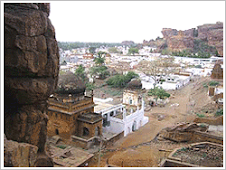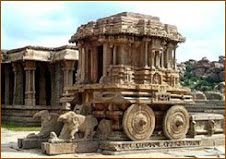Badami is the epitome of Karnataka's love towards art and architecture. This north Karnataka site is known for its beautifully carved cave temples, artificial lake, museums and rock-cut into the cliff face of a red sandstone hill of 6th & 7th Century. This village is located at the beginning of a ravine in the midst of red sandstone hills in northern Karnataka. Badami is an excellent tour option in case you like to explore the remains of the distant past in the form of caves, temples and forts, other monuments and ruins that remind you of the grandeur, lifestyle and ways of the past. Travel to Badami can be the ideal holiday choice.
Badami was at one time the capital of the Chalukyas. The Pallavas, who had been defeated by Pulakesi II, later captured and destroyed Badami to avenge their defeat. Badami was also in the possession of the Vijayanagar Kings, the Adil Shahis, the Savanur Nawabs, the Marathas, Hyder Ali and finally the British who made it part of the Bombay Presidency. A number of annual temple festivals are held in towns near Badami. The annual temple festival, held at Banashankari, in the month of January-February is worth visiting; so are the Virupaksha Temple Car Festival and Mallikarjuna Temple Festival held in Pattadakal during March-April.
Prime Attractions in and Around Badami
There are several places of tourist interest in Badami that you may tour during your stay in Karnataka. Rock–cut cave Temples, Gateways, Forts, Inscriptions, Sculptures that seem to come alive before your eyes. There are several monuments in Badami that were constructed during the 6th and 7th centuries. However, the town is best known for its cave temples, cut into the cliff face of the red sandstone hill and connected by flights of steps. They display the full range of religious sects, which have grown up on Indian soil. Two of them are dedicated to Vishnu, one to Shiva and the fourth is a Jain temple.
There's also one natural cave, which is a Buddhist One of the many masterpieces to be found in these caves is the famous, 18-armed Nataraja (Shiva) who if observed closely, strikes 81 poses. Cave 4, the last cave, is the only Jain Temple in Badami. The 24th Tirthankara-Mahavira, is seated in a uniquely comfortable pose here, against a cushion in the inner sanctum. Also a must see are Bhutanatha temples that lend their names to the lake just beneath the cave temples. Take a dip in this green tranquil waters as it is said to have the healing properties. On the other bank of the ancient Bhutnatha lake, astride whose shores the caves stand, is the shrine of Nagamma, the local serpent goddess, within a massive tamarind tree. Nearby, are two Shiva temples. Within the inner sanctum, on the edge of the water, He sits in a rare pose, leaning back, in all his awesome majesty.
The archaeological museum of Badami has Nandi, Lord Shiva's bull, at its entrance. This museum is closed on Fridays. It houses superb examples of local sculptures, including the remarkable Lajja-Gauri images of fertility cult, which flourished in the era. Badami Fort is strategically situated on top of the hill, enclosing large granaries, impressive temples on top of the northern end of the hill. Malegitti Shivalaya, perhaps the oldest temple of the lot, is dedicated to the benign aspect of Shiva as the garland maker. Placed on the summit of a rocky hill, the temple is built of stone, finely joined without mortar and with Dravidian tower. The lower Shivalaya has a Dravidian tower of which only the sanctum remains now. Around Badami there is the Naganath Temple, which is 10 Kms away and located in a forest on the way to Mahakuta. It is one of the early Chalukyan temples dedicated to Shiva.
Subscribe to:
Post Comments (Atom)







No comments:
Post a Comment